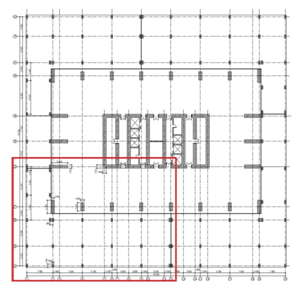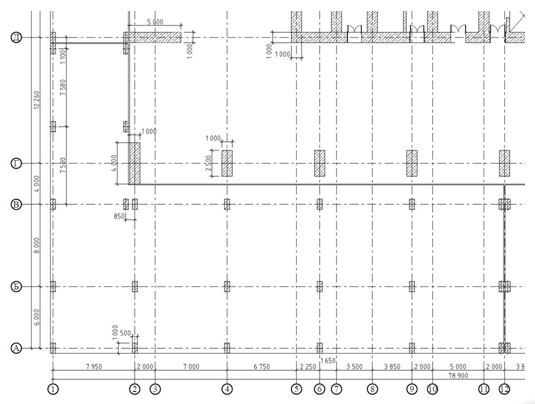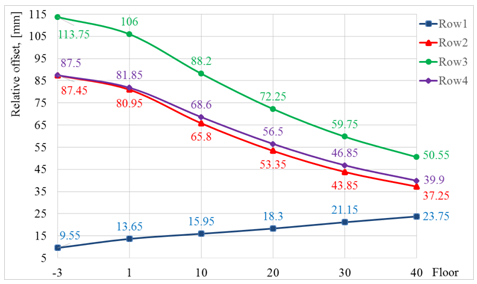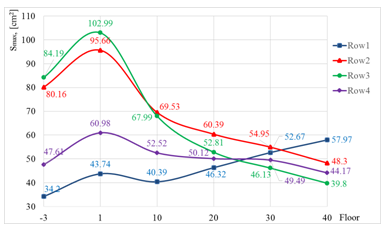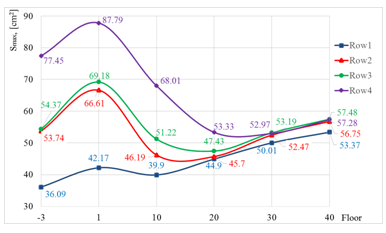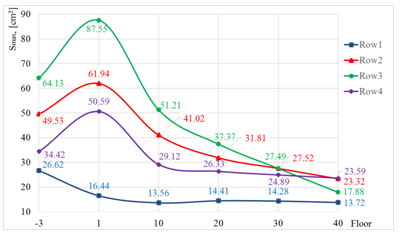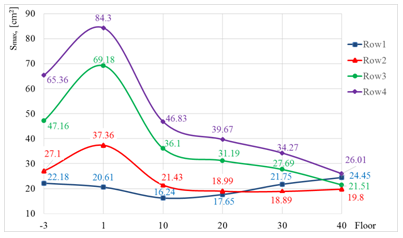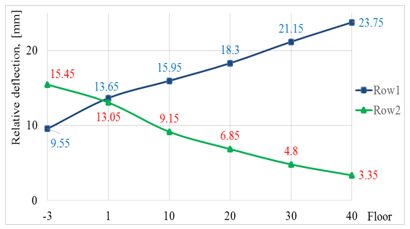РЕЗЕРВИРОВАНИЕ ПРОЧНОСТИ НЕСУЩИХ КОНСТРУКЦИЙ ВЫСОТНОГО ЗДАНИЯ ДЛЯ ПРЕДОТВРАЩЕНИЯ ВОЗМОЖНОГО ПРОГРЕССИРУЮЩЕГО ОБРУШЕНИЯ
Омармагомедов И.М.1, Завьялова О.Б.2
1Аспирант, 2Кандидат технических наук, Астраханский инженерно-строительный институт
РЕЗЕРВИРОВАНИЕ ПРОЧНОСТИ НЕСУЩИХ КОНСТРУКЦИЙ ВЫСОТНОГО ЗДАНИЯ ДЛЯ ПРЕДОТВРАЩЕНИЯ ВОЗМОЖНОГО ПРОГРЕССИРУЮЩЕГО ОБРУШЕНИЯ
Аннотация
В статье рассмотрена методика расчета многоэтажного монолитного каркасного здания на устойчивость к прогрессирующему обрушению. Даны рекомендации по определению конструкций, подлежащих усилению, и предложены меры, повышающие жизнеспособность уникальных зданий.
Ключевые слова: высотные здания, прогрессирующее обрушение.
Omarmagomedov I.M.1, Zavyalova O.B.2
1Postgraduate student, 2Ph.D. of Technical Sciences, associate professor, Astrakhan engineer building institute, Astrakhan, Russia.
STUDY OF BEARING STRUCTURES STRENGTH RESERVATION PREVENTING POSSIBLE PROGRESSIVE COLLAPSE OF HIGH-RISE BUILDINGS
Abstract
This article describes the method of estimating the resistance to progressive collapse of multi-storey monolithic frame buildings. It also gives recommendations for the structures to be strengthened and proposes measures that increase the viability of unique buildings.
Keywords: progressive collapse, high-rise buildings.
Progressive collapse is a sequential destruction of the supporting structures of the building or construction, resulting fromlocal damages and failure of the load-bearing structures, which leads to destruction of parts of buildings, and even whole building in the worst case. The strength analysis of tall buildings should pay special attention to the requirements of the relevant regulatory documents [1], [2], [3] to ensure the bearing capacity and stability of the separate parts and the whole building. One of these requirements is to estimate the possibility of a progressive collapse in case of a local collapse of one of the vertical load-bearing structures of the building. Besides that, in case of failure of any single vertical load-bearing structure (column, pylon, part of the wall), the remaining part of the building should be geometrically unchanged.
Analysis of progressive collapse should be performed on a special combination of loads [1], which includes standard values of permanent and temporary long-acting loads, taking into account the load combination factor y= 1. All loads considered as static. According to [1] temporary loads are taken with reduction factors:
- for loads from vehicles - 35% of the total normal load value;
- for the snow - 50% of the total value.
It is necessary to note that according to [4] in particular combinations of loads (the impact of the explosion, a collision of a vehicle with bearing structures of the building) temporary and short-term loads may be neglected.
In most cases, removal of one of the supporting structures leads to an overload of the adjacent structures, thus causing increase in stresses that exceed their carrying capacity. The main and themost simple method of protecting buildings from a progressive collapse is to reserve strength ofthe load-bearing structures.
According to [2] and [3] in case of a local collapse of one of the vertical load-bearing structures, which is a support for a monolithicslab, should not happen collapse of the latter. However, the magnitude of the cracks in the slab and the deflection is not limited. Thus, we can also reserve strength of not only the vertical, but also horizontal load-bearing structures - slabs, installing additional reinforcement.
Statement of the progressive collapse estimation problem
As an example let's consider analysis of a high-rise apartment building with monolithicreinforced concrete frame, which has 42 floors (excluding technical) in the high-rise part and four floors in the stylobate part. Vertical load-bearing elements are pylons. There is a monolithic load-bearing core in the middle part of the building. Monolithic ribbed slabs has a thickness of 25 cm. The analysis of the building for the resistance to a progressive collapse is conductedwith a special combination of loads, including permanent loads and possible schemes of local damage. Thecombination of loads in this analysis takes into account only the permanent load and own weight of structures in accordance with the requirements [4]. This progressive collapse analysis considers the following schemes of local damages:
- destruction of column-pylons, located in the corner part of the high-rise part of the building;
- destruction of columns, located on the second or penultimate longitudinal axis in the stylobate level of the building.
In total there were considered three options of removing columns in the high-rise part and three options in the stylobate part. Since these parts are separated by monolithicisolation joints, the forces from one part to another are not transmitted.
All calculations are performed in theeducational version of the software complex "Lira-SAPR". Figures 1 and 2 show the architectural layout of the building and its fragment to indicate the removed structure.
The results of the analysis
Option I: removed a column from the -3 floor of the stylobatepart of the building at the intersection of the axes 9-Б; removed a column-pylon from the -3 floor of the high-rise building at the intersection of the axes of 4-Г.
The forces in the columns and pylons, located in the immediate vicinity of the removed ones, are presented in the table 1.
Figure 1 - The architectural layout of the supporting structures of the high-rise building on the -3 floor. This fragment is used to simulate the local destruction of the vertical load-bearing structures
Figure 2 - The architectural layout of the structures in the considered fragment of the building
Table 1 – сompression forces in a column or a pylon, kgf
Let's estimate the carrying capacity of the columns that have received additional forces. It is known that the safety factor of concrete is 1.3 [5]. Thus, for a transition from the estimated resistance to the regulatory resistance, the calculated should be increased in 1.3 times. In addition, it is possible to consider the increase of concrete strength over time (about 1.25) [6]. General increaseof the carrying capacity of the column will be 1,3x1,25xγ=1.46, where γ=0,9 - givensafety factor. Thus, the maximum permissible load on the column can be increased in relation to the estimated by 46%.
Conclusion: the destruction of the column and the pylon located at the intersection of the axes of 4-Г and 9-Б, the destruction of adjacent columns and pylons are not expected, as the increase of their compressive forces does not exceed 46%. Thus, the reserve currying capacities of the columns and piers are sufficient.
Option 2: removed a column from the -3 (underground) floor of the stylobate part of the building at the intersection of the axes 6-Б; removed a column-pylon from the -3 floor of the high-rise part of the building at the intersection of axes 2-Г. The results of calculations are given in the table 2. Previously, in the collapse analysis of the option I, therewas obtaineda factor increasing the load capacityequal to 1.46.
Table 2 – сompression forces in a column or a pylon, kgf
It's worth to recall that in progressive collapse calculations in accordance with [4] temporary and short-term loadsare allowed to neglect, which explains the decrease of longitudinal forces in some of the pylons and columns calculated of the analyzed high-rise building.
Conclusion: the destruction of the considered structures (columns and pylons) leads to an overload of some of the adjacent ones, but despite this, a sufficient load-bearing capacityis provided. It is not necessary to strengthen the structures in this case.
Option III: removed a column from the -3 floor of the stylobate part of the building at the intersection of axes 4-Б; removed a column-pylon from the -3 floor from the high-rise part of the building at the intersection of axes 3-Д. The results of the calculations are given in the table 3.
Table 3 – сompression forces in a column or a pylon, kgf
Conclusion: the safety factors of the column 4-A and pylon 3-Е are not sufficient, thus when constructing their cross-section the obtained forces should be taken into account to prevent a collapse of these structures.
Analysis and strength reservation of monolithic slabs
Attention is drawn to the fact that despite the lack of limits on the magnitude of crack openings and deflections in the floor slabs [4], it is necessary to reserve strength of not only the vertical load-bearing structures, but also horizontal, thus providing them with sufficient load-bearing capacity not only for the 1 group of limits, but also for the 2 group if possible. Strengthening slabs installing additional reinforcement, comparison of their deflections, as well as possible methods preventing their destruction by a local damage to one of the vertical load-bearing structures is discussedbelow.
Let's compare the maximum deflections of monolithic slabs of high-rise part of the building in the normal case and in the previously discussed options of local damages of column-pylons at the base of the high-rise part. The results are shown in Figure 3 for -3 (basement), 1, 10, 20, 30 and 40th floors. All the diagrams have the same notation: Row 1 - offsets in the normal case; Row 2 - offsets in case of option I;
Row 3 - offsets in case of option II; Row 4 - offsets in case of option III.
Comparing the results, one can note that all the considered slabs got the additional offset from the local collapses, andan additional deflection on the upper floors is reduced by the slabslaying below.
In addition, the required reinforcement areasof the examined slabswere obtainedfor the normal case and the previously discussed options of local damages of columns and pylons in the high-rise part. The results are shownon Figures 4-7 (the notation is the same).
Figure 3 - Maximum slab offset variation relative to the height of the building for different variants of local collapses.
Figure 4 - Variation of the required reinforcement area of a slab over the upper plane along X-axis, [cm2/m]
Figure 5 - Variation of the required reinforcement area of a slab over the upper plane along Y-axis, [cm2/m]
Figure 6 - Variation of the required reinforcement area of a slab over the bottom plane along X-axis, [cm2/m]
Figure 7 - Variation of the required reinforcement area of a slab over the bottom plane along Y-axis, [cm2/m]
All the diagrams has the extreme values ofpercents of reinforcement corresponding to the slab of the first floor, which carries large, in comparison to the rest of the slabs, temporary and permanent loads. For all the considered options of local damages a significant increase of reinforcement is required only to 20-22 floors, further increase of the internal forces in the slabs is small and does not require a safety reservation. However, the solution of strengthening of horizontal bearing structures can be irrational, since in that case it is necessary to reinforcethe slabs receiving large deformation. Ultimately, the solution to this problem for the whole building can be very expensive.
Rational methods for solving such problems may be the construction of a stiffness floor (outrigger) on the bottom of a high-rise building, and an unloading slab facility. The latter is the most simple design and technological solution. The unloading slab is a monolithic slab with high stiffness (many times higher compared to a normal floor slab), receiving additional bending moments arising from local collapses of vertical load-bearing structures. As a result, located above the unloadingslab floors do not receive excessive deformation. This solution is more efficient and optimal than the reservation of slab strength on each floor.
Among the three different analysesof progressive collapses maximum offsets were obtained for the variant II. Let's consider this as option again, but this time with the unloading slab on the 1 floor. The given thickness of the slab is 2000mm. Parameters of the concrete and reinforcement are the same as in the previous calculations.
Figure 8 - Variation of the maximum offset of slabs over the height of the building for the normal case and for the variant II of local damages with the unloading slab: Row 1 - offsets for the normal case; Row 2 - offsets for the variant II of local damages.
Comparing the results with the normal case, we conclude that the offsets of slabs increase over height with lower intensity compared to the normal case. Offsets of slabs over the 6th floor (on the figure 8) will be smaller. This is due to redistribution of the vertical loads by the unloading slabto more rigid vertical structures - in this case the load-bearing core.
Conclusion
- The primary means of protecting buildings from a progressive collapse is reservation of the load-bearing elements strength by the method discussed in this paper.
- Slabs strength reservation using additional reinforcement may not always be rational, which could lead to higher prices for the project, as well as an increase in the complexity of installation. The most simple technological and cost-effective solution is to use an unloading slab which provides additional strength and prevents large deformations. On the other hand, an unloading slab promotes redistribution of loads on the vertical structures proportionally to their stiffness, which provides more uniform deformation of the foundation and the base.
References
- STO-008-02495342-2009 "Prevention of progressive collapse of monolithic reinforced concrete structures of buildings." Design and calculation.
- TSN 31-332-2006. - St. Petersburg.
- MGSN 4.19-05 "Multifunctional high-rise buildings and complexes." Volume II.
- SP 20.13330.2011 "Loads and effects."
- SP 52-101-2003 "Concrete and reinforced concrete constructions without prestressing reinforcement."
- Shapiro G.I., Korovkin V.S.,EysmanYu. A. et al., "Recommendations for the protection of frame apartment buildings in emergency situations", MNIITEP, NITzStaDiO, M., - 2002.

